Tekken and SoulCalibur: The Legacy of Yoshimitsu
It's a namesake that transcends time. A series of noble, if offbeat, warriors who have taken on Darth Vader, Pac-Man, and Anna Kournikova.
When a video game company makes enough fighting games, usually we start seeing some connections. Capcom’s Street Fighter introduces a Japanese schoolgirl and she later shows up when Capcom makes a fighting game about Japanese high schools. SNK’s Art of Fighting takes place a few decades before Fatal Fury, several centuries after Last Blade, and about a century before Savage Reign. NetherRealm can’t make a game about DC Comics characters without Mortal Kombat dudes showing up. Arc System Works has a big crossover game that just came out of some of their properties mashed together.
For Bandai-Namco, their staple fighting game series Tekken – the modern civil war within the Mishima bloodline – and SoulCalibur – the ancient war between two mystical swords – are bridged together mainly by one name: Yoshimitsu, the Cyborg Robin Hood.
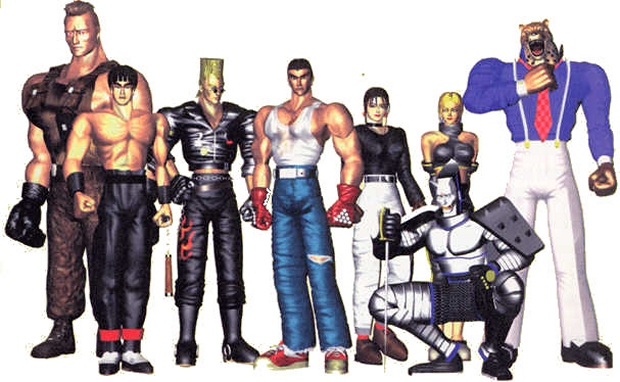
Yoshimitsu was at the ground floor, appearing in 1994’s Tekken. Even in a game featuring a robot and a man with a jaguar mask, Yoshimitsu was the token freak. He was to Tekken what Blanka was to Street Fighter, Baraka was to Mortal Kombat, and Gen-An was to Samurai Shodown. It wasn’t just that he wielded a sword in a hand-to-hand combat tournament. It wasn’t just the demon mask he wore. It was his bizarre fighting style that felt like a kabuki actor, a samurai, and a disco dancer joined together and got really drunk.
While the first Tekken is Yoshimitsu’s first real showing, we’d later get to see the origins of his legacy in 1998 with the release of SoulCalibur. The sequel to Soul Blade (or Soul Edge, depending on which version you’re playing), the game took place in the late 1500s and revolved around lots of post-medieval warring over a giant, evil sword covered in gross eyeballs called the Soul Edge. With all that sword-fighting going on, why not throw in Yoshimitsu?
Or, to be more specific, a Yoshimitsu?
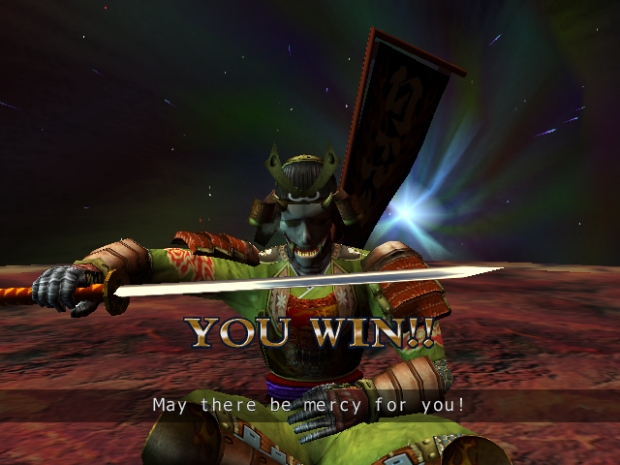
Real-life Japanese leader Oda Nobunaga wanted the mysterious Manji Clan to join his side. Yoshimitsu went and politely declined for the umpteenth time, but upon returning home, he found that Nobunaga’s forces had wiped out the entire clan for the “insult.” Yoshimitsu went after Nobunaga himself, but was overwhelmed by his army and got his arm chopped off in battle. Replacing his arm with a steampunk prosthetic, Yoshimitsu went on a one-man mission to find the most badass sword ever and get his revenge.
Read the latest Den of Geek Special Edition Magazine Here!
Since there was news of an azure knight going around killing everything with a bigass eyeball sword, Yoshimitsu followed the bloodshed. At some point during his adventure, he decided that maybe vengeance wasn’t the best course of action because he didn’t want to become a figurative monster like Nobunaga or a literal monster like Nightmare. Yoshimitsu never did come across the villainous knight, but he got close enough that his own sword became possessed by traces of the Soul Edge’s evil, giving it an otherworldly glow.
Yoshimitsu decided that he would not allow the katana’s evil to overwhelm him and set out to conquer it. From there, he became a heroic bandit who looked out for the poor and the weak. He made enough of a name for himself that others sought him out to join his side. From there, the Manji Clan was reborn as the Manjitou with Yoshimitsu the First at its helm.
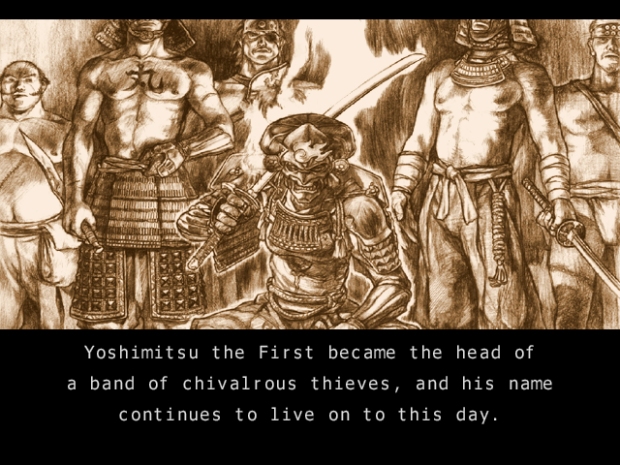
He would return in SoulCalibur 2, alongside another Soul/Tekken connection where Heihachi Mishima would magically travel back in time in the PlayStation 2 version of the game. Fun fact: originally, the PS2 SoulCalibur 2 was supposed to have Cloud Strife as the exclusive guest character (going with GameCube’s Link and Xbox’s Spawn), but the deal fell through and they plugged Heihachi in there.
Yoshimitsu’s rivalry was a natural one, putting his “steal from the rich and give to the poor” personality against the gimp-esque Voldo, who is dedicated to hording treasures for his long-dead master. The fact that they’re both as unorthodox as you can get only helps feed the concept.
As of SoulCalibur 3, his clan had two main focuses: 1) find treasures and spread their wealth to the poor and 2) find and destroy all remaining shards of the Soul Edge. Kind of like if Lord of the Rings had a bunch of kooky ninjas and more stuff to destroy than a single ring. Unfortunately, that mission led to disaster as one of Yoshimitsu’s top soldiers went insane from a shard of the broken sword and betrayed the rest of the clan. Yoshimitsu’s ending had zero to do with that and instead focused on him stealing more gold.
His SoulCalibur 4 subplot centered around Tira – essentially Harley Quinn as Gollum with a hula hoop enthusiasm – killing one of Yoshimitsu’s guys. Again, this is in no way reflected in his ending, where he spares the life of the final boss Algol and tells him to get over himself.
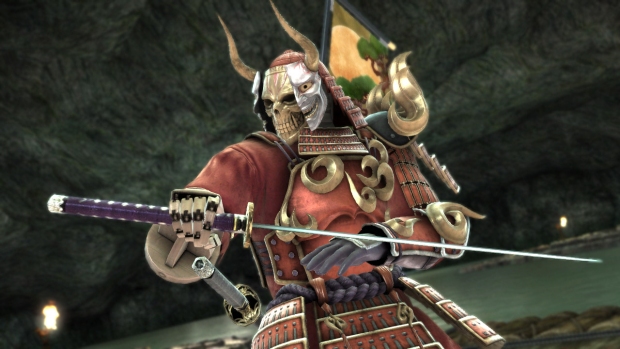
With all these prequel games, it still wasn’t 100% clear if Yoshimitsu was a legacy concept or an immortal with zany fashion sense. SoulCalibur 5 made it apparent that it’s the former as Yoshimitsu found out about the resurrection of regular series villain Cervantes and decided to nip that problem in the bud. Due to age and lack of character importance in comparison, Yoshimitsu got mortally wounded. He survived long enough to find a successor to kill him in battle and take both his sword and name.
Even then, the ill-fated Yoshimitsu the First was able to chop off his successor’s arm before going down for good.
Not much became of Yoshimitsu the Second. SoulCalibur 5 lacked endings outside of its main story mode campaign, so Yoshimitsu was pretty much left to the wayside. Then it was made clear that SoulCalibur 6 will be a rewrite of the earlier games, so all we’ll remember Yoshimitsu the Second for is his sweet skull mask within an oni mask look.
The legacy continued for centuries with there always being a new Yoshimitsu to wield the sword because apparently it’s part of the lore that the sword can’t be used against you if you take up the mantle. Speed up to modern day and we’re back to Tekken 1, where Yoshimitsu entered the King of Iron Fist tournament to mess with greedy, horny-on-main, sumo guy Ganryu and ultimately stole a bunch of his fortune so he could give it out to poor people, such as Marshall Law and his family.
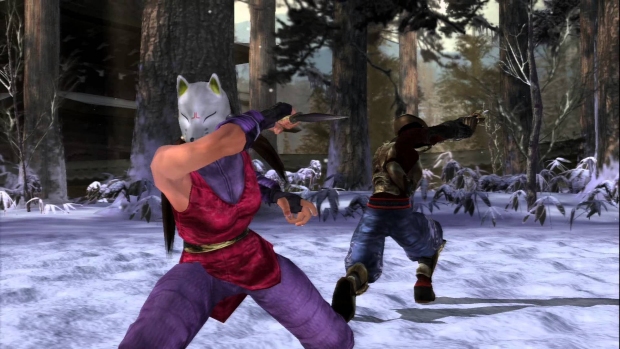
The game also introduced Kunimitsu, Yoshimitsu’s Manji Clan underling. While Yoshimitsu was about stealing from the villainous Ganryu and giving to the poor, Kunimitsu was all about stealing from the heroic Michelle Chang and giving to himself…er, herself. Namco depicted Kunimitsu as a man in the first game, but every appearance afterwards depicted Kunimitsu as a woman in a fox mask.
As of Tekken 2, Kunimitsu was excommunicated from the Manji Clan for stealing some of their funds. Her plot was that she wanted to take out Yoshimitsu and wield his sword for herself. Interestingly enough, while they never outright said what happened to her, Kunimitsu has yet to make a single canon appearance since then. She would just show up in Tekken Tag Tournament games and in the background of Street Fighter X Tekken.
She’s like the Boba Fett of Tekken, basically. Cool mask and look, but was only around for a cup of coffee. Still…somehow popular.
With Yoshimitsu’s Tekken 2 story, it was explained that around the time of the first game’s story, the Manji Clan tried to steal money from Heihachi Mishima’s vault and not only was it unsuccessful, but Yoshimitsu got his arm lopped off. For the first time in any game, we got robot-armed Yoshimitsu, as kindly mad scientist Dr. Bosconovitch rescued him and turned him into a cyborg. This gave Yoshimitsu helicopter hand abilities, which was essential because the game introduced boxing kangaroos and velociraptors, so he needed to weird up his repertoire to stand out more.
Dr. Bosconovitch was forced to do some mad science for new top villain Kazuya Mishima until Yoshimitsu paid him back by rescuing him and flying off with his sweet helicopter hand.
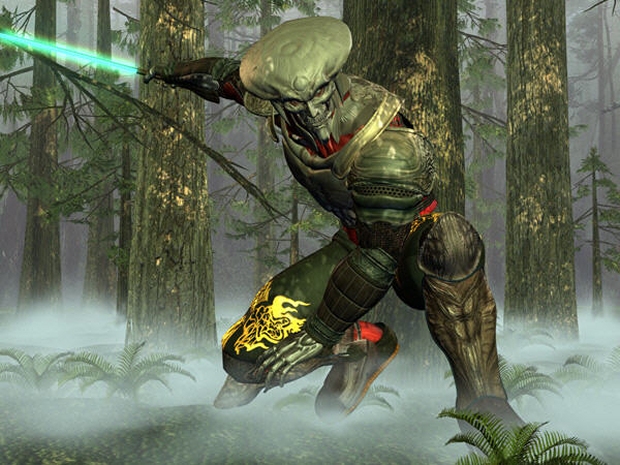
Tekken 3 jumped ahead a generation to play up the new teenaged hero Jin Kazama. Yoshimitsu traded his oni mask and classic attire for something a bit more outrageous. He instead became some kind of cyborg Predator thing, which became his most iconic look. Makes sense, since Tekken 3 is the highest-selling entry in the series (and the highest-selling fighting game that isn’t part of the Super Smash Bros. franchise). Plus it got him a guest appearance in Anna Kournikova’s Smash Court Tennis, where he got to use his katana rather than a tennis racket.
Storywise, Yoshimitsu was out to save the life of Dr. Bosconovitch yet again, though this time he was dying from illness. The idea was that he could possibly come up with a cure based on stealing the blood of Ogre, the game’s final boss and the Aztec God of Fighting. While Ogre got his ass handed to him by Paul Phoenix and Jin Kazama, Yoshimitsu still stole a blood sample. Presumably, they figured out the cure in the end, but when they fed the blood sample to a little mouse for testing, it caused the tiny rodent to go full-on kaiju.
Yoshimitsu showed up in Tekken Tag Tournament, which brought back Kunimitsu. Their endings were basically the same, showing them doing the cliché rushing sword attack thing where two people dash past each other and one of them falls over after a delay. The winner depends on which character you use.
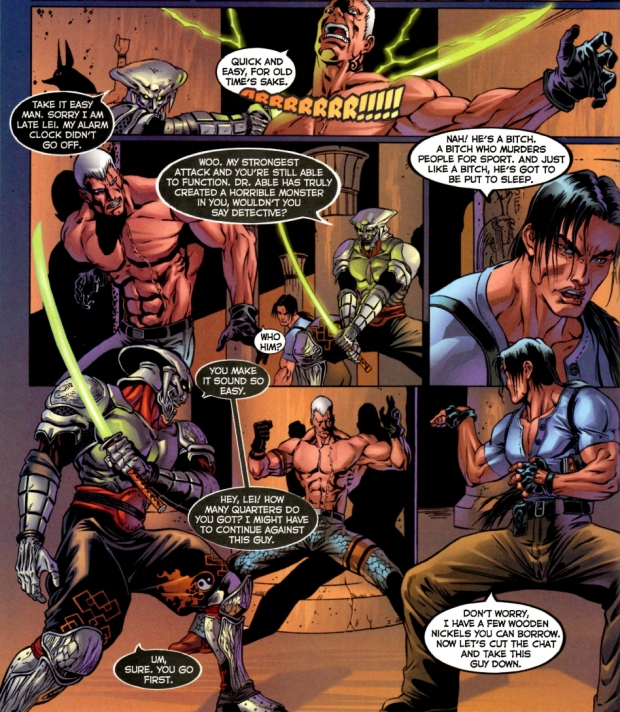
Tekken Tag Tournament also led to a comic called Tekken Forever by Dave Chi and Paco Diaz for Image Comics. The whole thing was a mess of a story and the comic got cancelled after a single issue, but it did have enough Yoshimitsu to at least mention. He teamed up with Lei Wulong against Bryan Fury and made enough wisecracks to suggest that he was being depicted as pretty much Deadpool, even down to the fourth-wall breaking.
Tekken 4 came with another Yoshimitsu design, which happens to be my favorite. The dude dressed as a skeleton dressed as a beetle, complete with wings. The game’s overall plot was that Heihachi Mishima was putting his entire Mishima Zaibatsu up for grabs in the new fighting tournament. In Yoshimitsu’s non-canon ending, Heihachi would still refuse to hand it over, only to find out that the Manji Clan had already succeeded in stealing his money vault. Then Yoshimitsu would peace-out while deflecting bullets with his badass beetle armor.
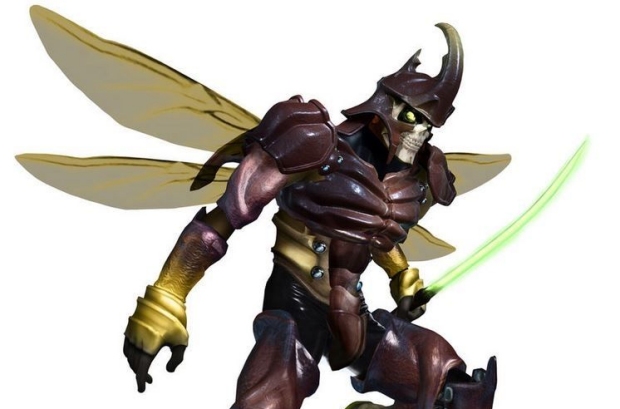
While that didn’t happen, he did have a role in Bryan Fury’s ending, which was very much canon. Bryan Fury is an undead cyborg corrupt cop whose appearance and Tekken 4 storyline are based on Roy Batty from Blade Runner. Despite being strong enough to throw tanks around, Bryan was on a biological time-limit and wanted to force Dr. Bosconovitch’s rival Dr. Abel into giving him more life. Bryan collapsed after punching the hell out of Abel and went lifeless.
Yoshimitsu found the body and handed him over to Dr. Bosconovitch, who offered to make Bryan a new, mechanical body. In return, Bosconovitch would study Bryan’s unused cadaver. Bryan silently agreed and the ending made it seem like we’d get a crazy, new version of Bryan in Tekken 5. Instead, Tekken 5 copped out by having Bosconovitch put a perpetual energy generator in Bryan’s body for the time being. Deciding that he got what he needed, Bryan went back against his agreement, attacked the doctor, killed a bunch of Manji warriors, and escaped.
Hence, we got a sweet Yoshimitsu vs. Bryan Fury blood feud going. Their endings were just the two of them killing each other in badass ways. Bryan’s had him being stalked by an invisible Yoshimitsu in the forest, missing entirely with a Gatling gun, and still being able to catch him out of the air with a handgun before finishing him off with a headshot. Yoshimitsu’s took place in the remains of a war-torn city, where he was not only able to evade the bullets, but cut through Bryan and make him explode. Yoshimitsu looked away and remarked, “Retribution.”
The game also introduced Raven, another new rival of sorts. A ninja himself, Raven and Yoshimitsu scoffed at each other before throwing down. Afterwards, Raven tried to teach Yoshimitsu his cool ninja hand seal gestures, but Yoshimitsu had no idea what he was doing and got constantly berated.
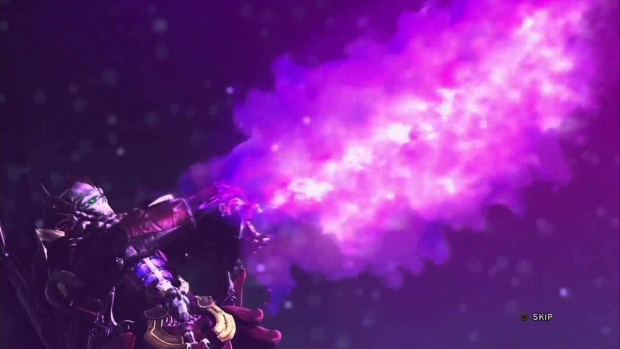
By Tekken 6, Yoshimitsu was a bit more distracted by his cursed katana acting up. The ending showed that had Yoshimitsu killed the villain Azazel, the final boss’ essence would have merged with the spark of Soul Edge in Yoshimitsu’s blade, both increasing his power to horrific levels and overwhelming him with pure evil. Probably for the better that Jin Kazama took care of the Azazel problem.
In 2009, we got a live-action Tekken movie and…it sure is a thing that exists. In a bastardization of the games’ story, we were granted a bastardization of Yoshimitsu. On the surface, he looked pretty damn good. His armor was probably the best we’d ever see a real-life Yoshimitsu look. Other than that, we got a soldier of Kazuya Mishima who got to use swords against Jin Kazama in a fighting tournament until Heihachi inadvertently distracted him and Jin turned it around.
Tekken Tag Tournament 2 was another non-canon entry that happened to have a huge collection of totally awesome ending cinematics. Unfortunately, three of them were dedicated to Yoshimitsu getting clowned. Raven met with Yoshimitsu in a forest for an off-mission battle and cut him down before returning to his task. Kunimitsu fought him in the same forest and seemingly lost the fight, only to somehow swipe Yoshimitsu’s sword and take off (causing Yoshimitsu to openly admit how much she had improved). Then Bryan’s had Yoshimitsu attempt to ambush him in his own hideout, only to have Bryan sidestep all the invisible swordplay, put Yoshimitsu through a wall, then detonate a bomb he tagged him in.
At least we got Yoshimitsu’s completely badass ending where he got the better of Bryan. Even with Bryan wielding a giant fuckoff laser cannon, Yoshimitsu was able to both dodge the beam and just rush through it with his sword as a deflector. Finally, he chopped Bryan in half, who once again exploded, only this time after laughing about dying in the coolest way possible.
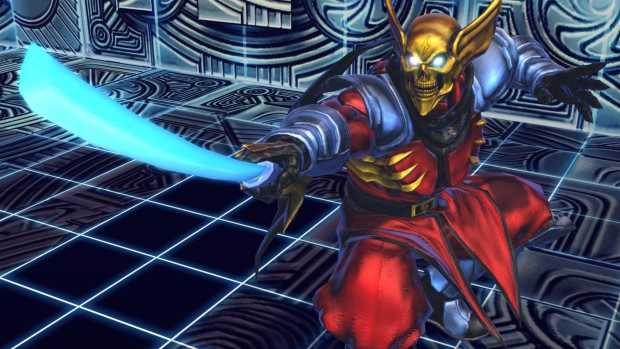
Capcom’s Street Fighter X Tekken gave us the novelty of playing as a Capcom-style version of Yoshimitsu, back to his Tekken 3 look. The game’s plot revolved around a mysterious box called Pandora that landed in Antarctica with various duos racing and fighting over it. Yoshimitsu noticed his cursed sword being called to it and hired Raven to watch his back. What followed was Raven insisting they be discrete and stealthy while Yoshimitsu joked around, talked like Yoda, and regularly changed his decisions on a whim.
Their rivals were Vega and Balrog, who Yoshimitsu insisted on facing honorably. Eventually, their ending led to Yoshimitsu being briefly possessed by his sword and attacking Raven. Raven accidentally got stuck inside the Pandora box and Yoshimitsu walked off with the box on his back.
The sweet thing in this game was how they had various cross-alt costumes. What that means is that characters could dress like certain fighters from the opposing franchise. Like Tekken’s Kuma dressing like Street Fighter’s R. Mika. Yoshimitsu got the best out of this with an M. Bison attire complete with the gold Shadaloo symbol as a mask. That’s an alternate reality I’d want to see more from.
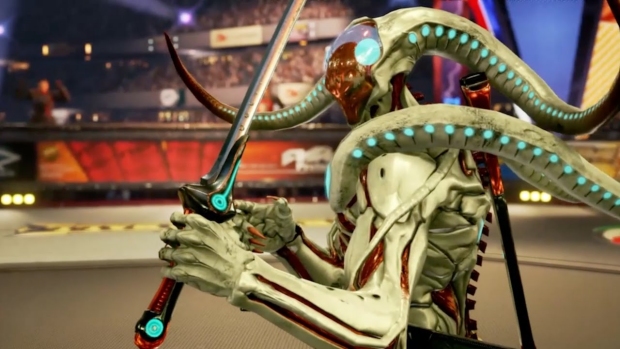
Speaking of his appearance, Yoshimitsu got his most outrageous one in Tekken 7, where he was a full-on octopus man. Just a bunch of tentacles hanging off his head and back for no reason whatsoever. Unfortunately, due to the very Mishima-based story of the game, the only lipservice most others got was a series of one-fight campaigns where selected characters would face a rival and get an ending cutscene. Why they didn’t just merge that with Arcade Mode, I don’t know.
Yoshimitsu’s rival was Leo and upon fighting, one of two things would occur. Either Leo would win and make comment of Yoshimitsu’s appearance before running off or Leo would kick Yoshimitsu in the junk before running off.
To tie-in with Tekken 7’s release, Titan Comics released a four-issue Tekken miniseries by Cavan Scott and Andie Tong. While it continued the war between Heihachi Mishima, Kazuya Mishima, and Jin Kazama, it at least found a way to include the other series mainstays by having Jin gather together a strike force made up of Nina Williams, Ling Xiaoyu, Panda, Paul Phoenix, and Yoshimitsu. Yoshimitsu didn’t really get much to do other than look weird and insult Phoenix.
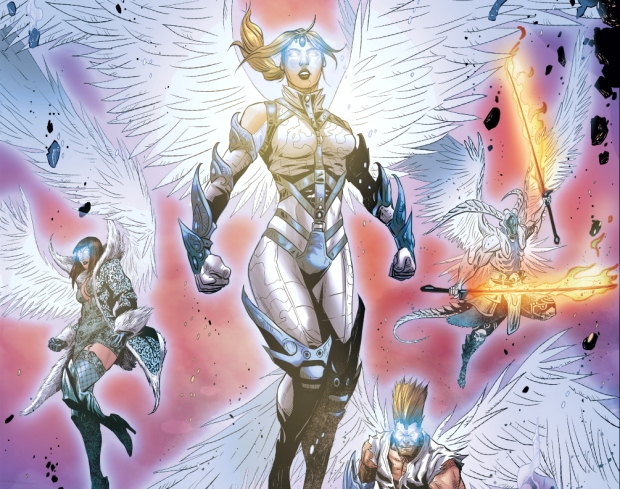
But hey, the final battle had Angel possess Jin’s comrades and set them against the Mishima trio. Angel Squid Yoshimitsu is kind of sweet, right?
Whatever his form, Yoshimitsu is part of Namco’s DNA. Tekken and Soul are outliers in the fighting game genre in that its protagonists are rarely good people. The first entries in each series had the “hero” win, only to unleash a reign of terror. But Yoshimitsu? There have been many of him, but they have all held onto the tradition of cracking down on the corrupt and coming to the aid of the weak while looking ridiculous and rad.
Maybe Nina shouldn’t have been the one Tekken character to get her own game.
Gavin Jasper thinks “Tears in the Rain” is a great scene and all, but maybe Rutger Hauer should have laughed before exploding at the end of Blade Runner. Follow Gavin on Twitter!3
